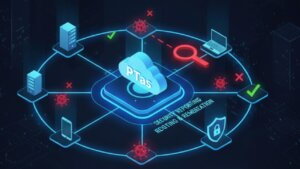Firewalls serve as the first line of defense against cyber threats by controlling the flow of data in and out of a network. They operate using predefined security rules that determine which traffic is allowed or blocked. Two fundamental types of firewall rules are inbound and outbound rules. Understanding their differences is crucial for configuring an effective security strategy that safeguards both incoming and outgoing network traffic.
Table of Contents
What Are Inbound Firewall Rules?
Inbound firewall rules control the flow of data entering a network. These rules determine whether external sources, such as users, applications, or devices from the internet, can access internal network resources. Proper configuration of inbound rules ensures that only legitimate and authorized traffic reaches the internal systems, preventing unauthorized access, malware infections, and other cyber threats.
How Inbound Rules Work
Inbound rules typically work by filtering traffic based on:
IP Addresses: Allowing or blocking specific IPs from accessing the network.
Ports: Permitting or restricting traffic on certain network ports.
Protocols: Controlling communication methods such as TCP, UDP, or ICMP.
Application Rules: Restricting access based on specific software or services.
For example, if a web server is running on a network, an inbound firewall rule can be configured to allow HTTP (port 80) and HTTPS (port 443) traffic while blocking all other requests. This prevents unauthorized services from gaining access.
What Are Outbound Firewall Rules?
Outbound firewall rules regulate the flow of data leaving a network. These rules determine whether internal users, applications, or devices can establish outbound connections to external servers or websites. Configuring outbound rules properly helps prevent data exfiltration, malware communication, and unauthorized access to malicious websites.
How Outbound Rules Work
Outbound rules function by analyzing:
Destination IPs: Blocking access to certain external sites or servers.
Port Numbers: Restricting outbound traffic based on application needs.
Protocol Types: Controlling the format of outbound communication.
Application Access: Allowing or denying specific applications from connecting to the internet.
For instance, a company may configure outbound rules to prevent employees from accessing non-work-related websites or to block certain applications from sending data outside the network.
Key Differences Between Inbound and Outbound Firewall Rules
| Feature | Inbound Firewall Rules | Outbound Firewall Rules |
|---|---|---|
| Traffic Direction | Controls data entering the network | Controls data leaving the network |
| Primary Purpose | Blocks unauthorized access from external threats | Prevents internal threats from connecting to malicious entities |
| Common Use Cases | Allowing access to web servers, VPNs, and remote desktop connections | Blocking access to restricted websites, preventing malware communication |
| Typical Security Approach | Highly restrictive by default | More permissive but requires monitoring |
Why Both Inbound and Outbound Rules Matter
A well-configured firewall should implement both inbound and outbound rules for comprehensive security. While inbound rules protect against external attacks, outbound rules help mitigate internal threats like malware infections, insider threats, and data breaches.
Real-World Example
Imagine an organization deploying an internal database server. The firewall administrator sets up inbound rules to allow connections only from specific IP addresses and over designated ports. Simultaneously, outbound rules are configured to restrict database servers from accessing the internet directly, reducing the risk of data leaks or cyberattacks.
Follow the Principle of Least Privilege (PoLP) – Only allow the minimum level of access necessary for operations.
Regularly Audit and Update Rules – Review firewall rules periodically to ensure security measures are up to date.
Use Whitelisting and Blacklisting – Define approved traffic sources while blocking known malicious entities.
Enable Logging and Monitoring – Keep track of firewall activities to detect and respond to threats.
Test Firewall Configurations – Simulate attacks and analyze firewall effectiveness in mitigating risks.
Conclusion
Understanding the difference between inbound and outbound firewall rules is critical to securing a network from both external and internal threats. While inbound rules focus on blocking unauthorized access from outside sources, outbound rules prevent malicious or unintended data from leaving the network. Implementing a well-balanced firewall strategy with both types of rules ensures a robust defense against cyber threats, keeping networks and sensitive data safe.
References
Why Businesses Trust SecureMyOrg for Comprehensive Network Security
At SecureMyOrg, we uncover and fix all possible security vulnerabilities of mobile and web, while providing solutions to mitigate risks. We are trusted by renowned companies like Yahoo, Gojek and Rippling, and with 100% client satisfaction, you’re in safe hands!







Some of the things people reach out to us for –
- Building their cybersecurity program from scratch – setting up cloud security using cost-effective tools, SIEM for alert monitoring, building policies for the company
- Vulnerability Assessment and Penetration Testing ( VAPT ) – We have certified professionals, with certifications like OSCP, CREST – CPSA & CRT, CKA and CKS
- DevSecOps consulting
- Red Teaming activity
- Regular security audits, before product release
- Full time security engineers.
Relevant Posts

AI-Powered Phishing Emails: 7 Ways to Spot and Stop Them Before They Strike
Penetration testing as a service (PTaaS) lets experts simulate real attacks to uncover vulnerabilities before hackers do. This guide explains the process, benefits, and costs, helping businesses strengthen defenses with predictable, ongoing security checks.

Why Regular Penetration Testing is Essential for Modern Companies
Penetration testing as a service (PTaaS) lets experts simulate real attacks to uncover vulnerabilities before hackers do. This guide explains the process, benefits, and costs, helping businesses strengthen defenses with predictable, ongoing security checks.

What Is Penetration Testing as a Service?
Penetration testing as a service (PTaaS) lets experts simulate real attacks to uncover vulnerabilities before hackers do. This guide explains the process, benefits, and costs, helping businesses strengthen defenses with predictable, ongoing security checks.

How To Inspect Encrypted Traffic Without Breaking Privacy
Network administrators face a challenge: securing systems while respecting privacy. This guide explains how to inspect encrypted traffic without breaking privacy using metadata, anomaly detection, and machine learning ensuring visibility, compliance, and trust.

How to Audit Infrastructure as Code (IaC) for Security Vulnerabilities
Discover how to audit Infrastructure as Code (IaC) for security vulnerabilities with this practical guide. Learn to scan IaC files using tools like Checkov, fix issues like exposed resources, and integrate audits into CI/CD pipelines. Protect your cloud systems from misconfigurations and ensure compliance with clear, actionable steps.

DevSecOps Best Practices: Integrating Security Early in Your CI/CD Pipeline
This article provides a practical guide to embedding security into every stage of your CI/CD pipeline. Learn core DevSecOps best practices like SAST, DAST, dependency scanning, secrets management, and compliance automation to catch vulnerabilities early, foster a culture of shared ownership, and build a secure-by-design development process that accelerates release cycles.
